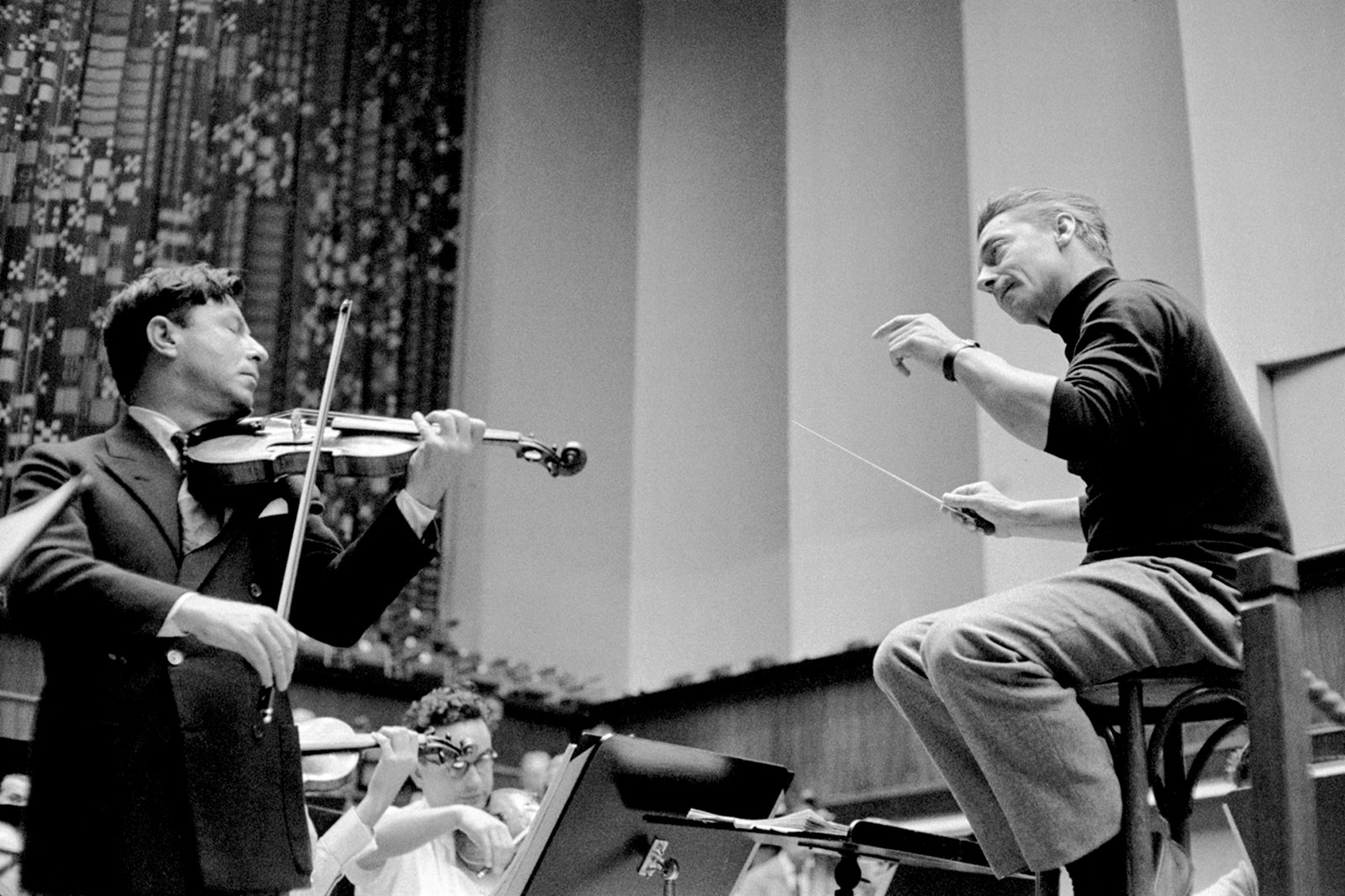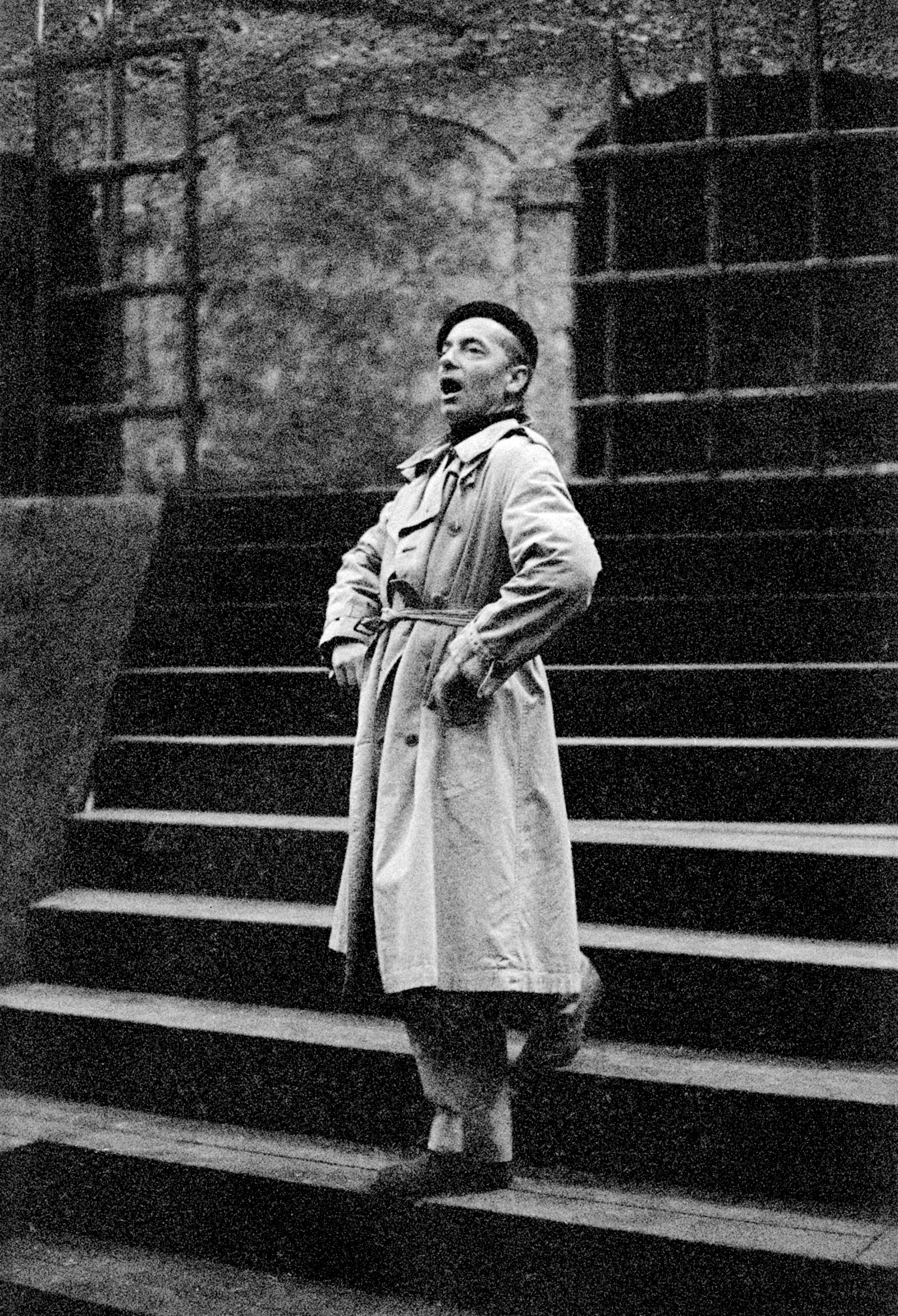The one-dollar tables outside secondhand bookstores often contain isolated volumes from what were once complete collections of a single author. There may be works by Mark Twain, Charles Dickens, or Nathaniel Hawthorne, but also by less well-remembered writers such as James Russell Lowell, Charles Dudley Warner, or John Galsworthy. Abandoned in piles otherwise devoted to forgotten best sellers or Book-of-the-Month Club selections, these books may yet, by their very presence, inspire a distinct nostalgia.
I thought of these old sets while listening to a gigantic collection of recordings by Herbert von Karajan (1908–1989), released at the end of last year and billed as the Austrian conductor’s complete recorded output for Deutsche Grammophon and Decca. In all, there are 330 compact discs, twenty-four DVDs, two Blu-Ray audio discs, a handsome pictorial biography that would be worth having even without the music, and several booklets. There are 405 hours of music here: the first performance dates from 1938 (the overture to Die Zauberflöte with the Berlin Staatskapelle) and the last from April 1989 (Bruckner’s Seventh Symphony with the Vienna Philharmonic, a few months before Karajan’s death). According to the Guinness Book of World Records, which tracks such things, this is the “largest box set ever issued,” eclipsing a 2011 award presented to the late Arthur Rubinstein for the “largest boxed set of recordings by a single instrumentalist” (a total of 142 CDs).
The complete symphonies of Beethoven, Schumann, Brahms, Bruckner, and Tchaikovsky are here, as are the five mature symphonies of Felix Mendelssohn. Indeed, there are three different interpretations of the Brahms and Beethoven cycles, as well as video recordings of the latter.
And more: all of the operas Karajan recorded for the two companies, as well as twenty-four films he made for Unitel. There is Christmas music, a collection of famous adagios, a Viennese New Year’s Concert from 1987, a concert honoring Pope John Paul II, a premiere recording of a fascinating late work by Carl Orff (De temporum fine comoedia), and “complete-on-one-disc” 24 bit/96kHz Blu-Rays of his wildly popular early-1960s recordings of the Beethoven symphonies and of his meticulous and creatively cast performance of Wagner’s Ring cycle (both also represented on CD). And if this isn’t enough Karajan for you, there are 101 additional CDs awaiting you on EMI, in another recent reissue.
The sheer bulk of the set is overwhelming, and one can’t help wondering who will listen to it all. After all, we live in a world that offers the near-complete recorded output of Maria Callas and Renata Tebaldi and most of the albums released by Vladimir Horowitz over the course of sixty-one years (as well as a fifty-CD set of live performances that chronicle seismic ups and downs in the last part of his career), and virtually everything Arturo Toscanini, Pierre Monteux, Wilhelm Furtwängler, and Charles Munch ever conducted near a microphone. Moreover, if you are growing weary of Anne-Sophie Mutter, Hilary Hahn, and Itzhak Perlman, you can find the complete records of worthy but not exactly household-name violinists such as Johanna Martzy, Gioconda de Vito, and Eduard Melkus issued in Asia, where there has long been a huge hunger for rare recordings.
There is a simple reason for this proliferation: reissues are nothing but profit for record companies. There are no studio costs to pay, only a small fee to the musician’s union, and some residuals to the artist or the artist’s estate. It has long been considerably less expensive to spiff up and repackage an existing recording than to make a new one. The first stereo albums of Fritz Reiner and the Chicago Symphony, for example, sound as though they were recorded yesterday, although some of them are nearly sixty-five years old and every person associated with them is either dead or long retired. Brilliant young performers now have to compete not only with their contemporaries but also with a host of legendary ghosts. Through technology we have established a permanent pantheon of great performances, one that can be very difficult, perhaps impossible, for newcomers to crack.
Time was when fresh recordings were all but necessitated with every new technical advance, as the cracks and hisses of the four-minute 78s gave way to the quieter and more extended LPs in the late 1940s, monaural turned to stereo in the 1950s, and the compact disc seemed to replace the LP in the early 1980s. The critic Richard Freed, in a review he wrote for The New York Times of Karajan’s last recordings of the Beethoven symphonies, observed that “one comes away from the 1985 set with the feeling that what motivated it was not so much the idea of preserving the great conductor’s final thoughts on this very basic repertory as simply keeping up with the digital technology.” Now the “old” classical record business—the one that began in the final years of the nineteenth century and in which Karajan held a dominant position for several decades—seems gone for good. Still, the recordings remain, and the best of them are treasures.
Advertisement
Karajan said he wanted to combine the drive and precision of Toscanini with the fantasy and introspection of Furtwängler, yet he also reminds me of Leopold Stokowski. Like Stokowski—especially the Stokowski we know from early recordings with the Philadelphia Orchestra—Karajan often seemed a wizard of pure sound. One admired the gait of his tempos, the singing lines he drew from the players, the way his orchestras responded reflexively to his every gesture—but it was the sound, again and again, that astonished. A perfectionist, Karajan drove his forces as hard as he drove himself, striving always for balance, proportion, lucidity, and polish. He did not call undue attention to himself on stage, preferring to rehearse exhaustively with his musicians before the concert began. “His philosophy was that everything the orchestra needs had to happen beforehand,” one of his musicians said.
Richard Osborne, who knew Karajan and became his best biographer, wrote of a 1948 rehearsal with the Philharmonia Orchestra in London, explaining that the experienced players liked working with him because he never wasted their time:
At the final rehearsal for the Royal Albert Hall concert, he spent just eight minutes on Beethoven’s Fifth Symphony. He simply asked the orchestra to play the symphony’s final climax with as much volume as they could muster consistent with a balanced and fully rounded tone. All he wanted to know was what to expect on the night, what the dynamic parameters would be.
The critic Jay Harrison summed up Karajan’s conducting in the New York Herald Tribune:
His is a beat that strikes the eye as though reflected in still water, and it is the message conveyed by this beat that accounts for much of the limpidity of his work. Indeed, this grace of hand, all precise and controlled, has a tendency to soothe, permits the orchestra to retain its poise and equilibrium, and jars them not for a moment. A nervous orchestra, rendered frantic by wild arm movements, cannot under any circumstance play legatos as shapely and as silken as those which recurrently emerged last night…. Mr von Karajan, with a wondrous dignity and elegance, held his band in rein through every measure; but he did so with a suppleness and ease that allowed it to concentrate on the music and not every instant upon him.
And so his podium manners were few—large gestures for loud music, small gestures for soft music, a steady, fluid beat, fleshed out with an infinitely expressive left hand. The tuttis, no matter how softly they were played, were full-bodied, prismatic, organ-like in their euphony yet absolutely clear. Although Karajan stood only five feet eight inches tall, he seemed a veritable titan on stage, with a noble, granitic profile and a thick head of hair that, over the years, changed from iron gray to blanched white—an Apollonian contrast to the Dionysian Leonard Bernstein, his only contemporary whose fame was in the same league.
Artistic gifts aside, Karajan was a tough, canny musical politician. During the years between 1956 and 1964, he held five important European posts: music director of the Berlin Philharmonic (theoretically for life, although it didn’t turn out that way); de facto principal conductor of the London Philharmonia; a producer and director at La Scala; general director of the Vienna State Opera; and artistic director of the Salzburg Festival. He also directed film and television productions of his own austere, abstract operatic stagings. “We must use the mass media, especially television, to expand the popularity of music,” he said in 1967.*
The recordings begin with performances of works by Beethoven, Brahms, Mozart, Tchaikovsky, Dvořák, and others with the Concertgebouw Orchestra of Amsterdam, the Berlin Philharmonic, the Berlin State Orchestra, and the Symphony Orchestra of RAI, Turin, all dating from 1938 to 1944, when the host countries were under Nazi domination. (Karajan was quickly de-Nazified after the war, but his early membership in the Austrian party, which predated the Anschluss, came in for much criticism, to the point that his early American appearances inspired angry protests.) The distinctive mixture of objective and subjective elements in Karajan’s sensibility was there from the beginning. These early orchestras vary in their quality: the Turin radio symphony is pretty ragged, the Concertgebouw markedly better, and the Berlin Philharmonic, even in the early 1940s, sounds much like the tapered, almost impossibly elegant ensemble that it is today. Still, while there is much to admire in these early discs, it is mostly promise, and I don’t think that anybody would have reissued them had the conductor not gone on to greater things.
Advertisement
Karajan’s first mature performances, with the Philharmonia in the 1950s, were done for EMI and are not included here. The best recordings in the Deutsche Grammophon set date mainly from the 1960s and 1970s, during the time when Karajan was referred to, only half in jest, as the “general music director of Europe.” And although he continued to record through the 1980s, there was a precipitous decline in his later discs, as a combination of age, poor health, and a long-unchallenged ego took their inevitable toll.
Despite some lushly caloric performances of Haydn and Mozart, Karajan was mostly a nineteenth-century man. He directed Bach, Vivaldi, and other baroque works from the harpsichord, but many thought his style too luxuriant, and he was not always a convincing interpreter of that repertory. He developed an affinity for Mahler and the Second Viennese School (Berg, Schoenberg, and Webern) late in his career and conducted their works with conviction. He was not particularly interested in the music of his own time, although he played works by Boris Blacher, Wolfgang Fortner, and Hans Werner Henze. (An early exponent of Carl Orff, he nevertheless refused several offers to record Carmina Burana, which he left to Eugen Jochum—and by extension to the rest of the world.) Among the more modern Russians, he played some Stravinsky, Prokofiev, and Shostakovich, with distinction.
Karajan was picky about his Mahler, and he recorded only the Fourth, Fifth, Sixth, and Ninth symphonies as well as many of the orchestral songs, including Das Lied von der Erde. Those who want fierce and unbridled Mahler will find it more easily elsewhere; Karajan was never comfortable with emotional turmoil. And although he was persuaded to record the First Symphony of Sibelius late in life, he never conducted the Third and concentrated his energies mostly on the Second, Fourth, Fifth, Sixth, and Seventh symphonies, which he imbued with a peerless contradiction of fire and ice. He once named the Sibelius Fourth as a piece that left him spent for days: the others included Richard Strauss’s Elektra (which he never commercially recorded, although recordings of live performances exist), Mahler’s Sixth Symphony, and Alban Berg’s Three Orchestral Pieces.
In the end, things fell apart between Karajan and Berlin amid quarrels over his authoritarian control of the orchestra, and a few months before he died, he severed all ties with it. So he brought the Vienna Philharmonic for his last three concerts at Carnegie Hall in 1989. Ravaged by illness, he walked onstage with twisting, spasmodic jerks, pulling himself up to the podium with the help of the backrest. But when the music started, the years fell away, and one was constantly amazed by the dexterity—the shifting, ordered, kaleidoscopic process—with which one section of the orchestra passed on a theme to another. In the Schubert “Unfinished” Symphony, the lower strings played with a smoothness and repose that was all but unearthly; the music seemed to emanate from the walls. I’d never heard anything like it.
It is hard to tell how long the CD format will last in a world increasingly given over to streaming and digital downloads. Most of the albums in this set have been reissued before in other guises, and there are already generous Deutsche Grammophon sets devoted solely to Karajan’s Berlin Philharmonic recordings from the 1960s and 1970s, those peak decades in his life’s work. For many those will be enough, perhaps even more than enough. But my guess is that listeners who will find these discs in front of whatever passes for a music store in 2070 and can then assemble the equipment to play them properly will be pleased. As a massive monument to a time when the aspirations of classical music and technical commerce mated fruitfully, it can hardly be bettered.
-
*
The pianist Glenn Gould, who didn’t play a note in public for the last eighteen years of his life, preferring to work with television and radio, admired Karajan enormously, and the two of them once considered the possibilities of a long-distance recording—Karajan in Berlin or Vienna with Gould at home in Canada. ↩





